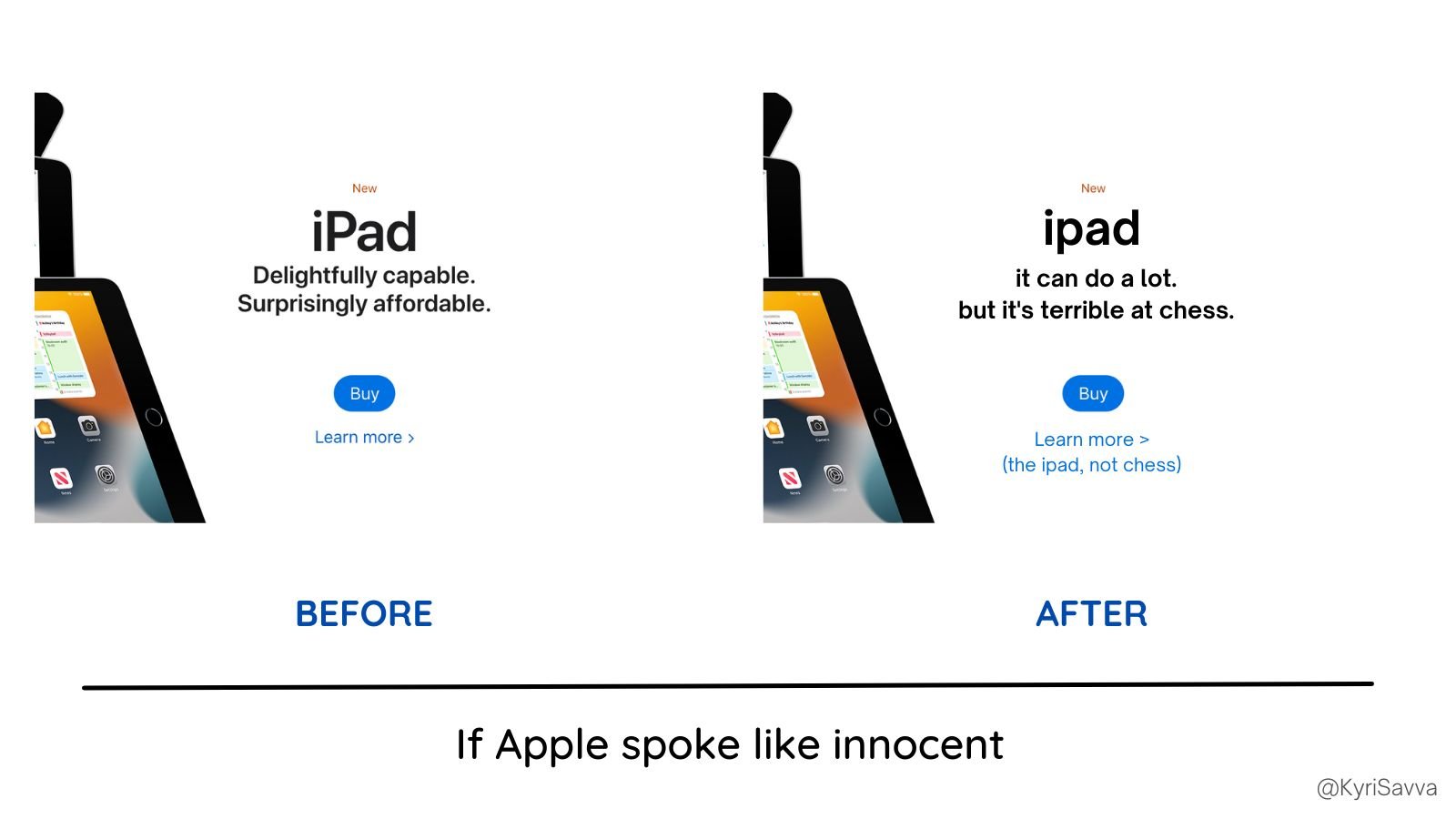Tone deaf? Why the way your brand speaks matters
Article by Hope Whitehead, Copywriter/Junior Strategist at HeyYou
A little while back, I saw a post on LinkedIn where someone had taken two brands - Innocent Drinks and Apple - and swapped the way they spoke.
It's an instantly recognisable change, even if it's nothing significant visually; we move to lowercase, yes, but very little otherwise shifts. Byron Sharp's concept of distinctiveness - those factors that not only set brands apart but maintain consistency within brands - is well-documented. But I think for most outside of the marketing/advertising industry, distinctiveness for brands is anchored in their visual elements. As this image shows us, that's a mistake:
Thanks Kyri S. on LinkedIn for this one
Apple and Innocent are two reliable tools in a marketer's toolkit: frequently used as examples when we work through aspects of brand with clients. Apple comes up often as a brand other brands wish to emulate, while Innocent is an example of a distinctive (cheers, Byron) tone of voice. Chances are, if you've ever had that concept explained to you, Innocent was the example used. The UK smoothie brand is well known for its endearing, witty way of speaking, which had a profound impact on many other UK brands. The rise of the phenomenon of wackaging, writing that - as anyone who's ever been to Marks and Spencer knows - has embedded itself into UK brand and packaging writing everywhere. Even the man behind Innocent's groundbreaking tone of voice has regrets about his role in creating brands that, as Eva Wiseman suggests, leave us 'being babysat by the stuff we buy'.
Grocery shopping in the UK can sometimes feel like you’ve fallen trolley-first into an episode of Peppa Pig
The frustration with the world of wackaging gives us insight into a small part of the tangible impact that tone of voice can have. It's easy to notice brands like Innocent, but if someone asked you to describe Apple's tone of voice, or Vodafone's, or Spark's, what would you say? Hard to pinpoint exactly what, but something differentiates all of those brands, right? If The Warehouse started writing like Hell Pizza one day, but changed nothing about their brand's look, you'd notice a change.
This is the stuff that I'm interested in, as a copywriter, as a consumer, as someone who just really likes words. My absolute favourite projects are the ones where I get to write a tone of voice guide. They're hefty, multi-page things, with tables and sometimes even little diagrams. It's surprisingly left brain stuff. These chunky sets of pages go out to brands to help people from in-house writers and marketers, to call centre staff, to social media managers do their thing - a good one sets out clear guidelines - what to do, what not to do, more x than x, and provides examples. It's a step further than brand personality: a development of your overall brand strategy into something that really - ahem - speaks. It becomes the guiding light that makes the brand feel consistent at every touchpoint. And from my work in the space, I think it's quite an inspirational process. I watch people who work in these brands every day find new things within them to be excited about. Like the brand strategy process, it opens doors to new ideas and helps the brand feel cohesive and effective. Of course, sometimes it can be really fun: I've had the opportunity to write guides for some epic brands who were keen to inject humour into their communications, and I'm eternally jealous of whoever got to write the guide for Pak'n'Save's Stick Man.
So, while tone of voice can be hidden in plain sight, it should be a consideration for any brand - at a minimum, it gives you distinctiveness. If you push it, you can disrupt, make waves, leave a mark. Its role in your positioning can't be understated: the difference between sophisticated or premium and mainstream, for example, is not all about design elements. Fundamentally, your brand's voice matters, and it's worth spending the time and the money on making sure it's right.



